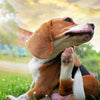10 Dog Breeds Pawfect for Cold Weather
- by Rufus and Coco
Beyond mere appearances, dog breeds exhibit varying abilities to endure and adapt to different climatic conditions, including extreme heat or bitter cold.
Today, we delve into the world of 10 dog breeds that thrive in the wintertime, outshining their performance during the summer months - the canine companions who truly come alive amidst the frosty landscapes of winter.
Dogs That Thrive During Winter
Siberian Husky
As its name suggests, this breed is genetically equipped to handle the cold. Its thick coat makes it more than capable of not just thriving in the winter but also enjoying activities such as playtime in the park even at temperatures below 0 degrees Celsius.

With a great coat comes great responsibility. These dogs tend to shed, so you need to keep their grooming under control with tools such as our Self Cleaning Deshedder Brush, a Detangling Comb, or a 4in1 Detangler & Pamper Spray.
Samoyed
As yet another breed hailing from Siberia, it goes without saying that the Samoyed thrives in cold weather rather than under the scorching summer sun. This is a dog that enjoys a lot of exercise because it was primarily bred for hauling sledges, herding, or hunting.

As pets, Samoyed dogs get very attached to their owners. They’re gentle and have a calm temperament, so they make a great fit for families with children. They don’t like being lonely, and they thoroughly enjoy long weekend outings together with their humans.
Saint Bernard
If there’s any breed that’s probably known by anyone in the world for features such as being huge, hardy, and capable of helping people stuck on mountains, that’s the Saint Bernard.

Due to its large physique and thick coat, a Saint Bernard does a lot better in cold weather than it does in the warmth. While this isn’t an overly active dog, it is incredibly resilient and affectionate and more than capable of showing its abilities as a working dog (especially in deep snow).
Because they have so much fur, you might need to give your Saint Bernard a dry or wet bath even in the winter, with products such as our Water Free Wash or our 2 in 1 Oatmeal & Aloe Wash.
Alaskan Malamute
Although very similar to the Siberian Husky in terms of physical appearance, the Alaskan Malamute is a whole different breed. Its double coat makes it the perfect dog for cold climates, but it does require a bit more care in the summer.

To make sure that your Malamute’s coat doesn’t get out of hand, you should use a Self Cleaning Slicker Brush. Although a haircut is recommended when the hot season comes around, you need to make sure that the trim is perfect – otherwise, it can ruin the Malamute’s coat forever.
Great Pyrenees
This is a dog breed that was essentially bred to herd livestock in the mountains of France, which means that it is made for cold weather. They love being active and useful, and they make great guarding dogs, too.

Characterised by a double coat and a substantial size, this breed's ability to withstand high temperatures isn't exactly great. However, behind their impressive stature lies a gentle giant, deeply oriented towards human companionship. Their remarkable affinity for people ensures swift and genuine connections, establishing them as steadfast and loyal friends.
Chow Chow
Not all Chow Chow dogs are the same. In fact, within the same breed, there are dogs that have rough coats and dogs that have smooth ones. Regardless of the type, they are known for their soft and almost woolly fur, so they have plenty of insulation.

In terms of grooming, their coat needs to be brushed at least 3 times a week to avoid extreme matting.
Although a calm and elegant dog in its essence, the Chow Chow needs to be socialised in order to properly respond to rough play, especially with children.
Newfoundland
Bred to endure the most unforgiving elements, this breed possesses an imposing stature. Its exceptional size is matched by a purposeful design, enabling it to withstand the harshest weather conditions. Equipped with a protective double coat, this breed has remarkable resilience against the biting cold.

Newfoundlands are known for being calm and somewhat low-energy, so don’t expect this dog to be running around all the time like a Chihuahua. They’re not particularly vocal either - unless something is happening or they require their owners’ attention.
Make sure you brush your Newfoundland dog’s coat at least once every couple of days to prevent it from getting out of hand.
Bernese Mountain Dog
This beautiful breed hails in Switzerland as a working dog, so it enjoys spending time outdoors and serving their owners in multiple ways. Known for its particular strength, the Bernese Mountain Dog revels in the constant companionship of both humans and fellow animals, exemplifying a desire for social interaction and harmonious connections.

In terms of their resistance to cold weather, Bernese Mountain Dogs are equipped with a double coat that repels moisture and keeps low temperatures manageable. A nice feature of these dogs’ coats is that they also repel dirt.
Anatolian Shepherd
Originating from Turkey, this is a breed that has good resistance to inclement weather. It’s a large and independent type of dog that enjoys being with people, and feels truly accomplished when it is useful.

Thanks to their thick undercoats, these dogs can handle the cold a lot better compared to other breeds. Although they have shorter fur than most dogs on this list, they do need to be brushed regularly to prevent their coat from getting tangled.
Akita
Besides being widely known for being one of the most loyal dog breeds in the world, the Akita has fairly good resistance to the cold thanks to its thick undercoat and rough outer one.

Although they are extremely friendly and social, they can also be a little stubborn if they aren’t trained while young. An Akita will always go out of their way to protect their human family, so this dog is the perfect example of a ‘man’s best friend’.
- Posted in:
- australia
- behaviour
- cat
- cat explorer
- cat facts
- cat litter
- cats
- clean-up
- dog
- dog facts
- exercise
- fun
- grooming
- health
- health-tips
- holiday
- how to help
- litter
- new arrivals
- new items
- news
- outdoors
- tips
- toys
- travel
- weekitty










